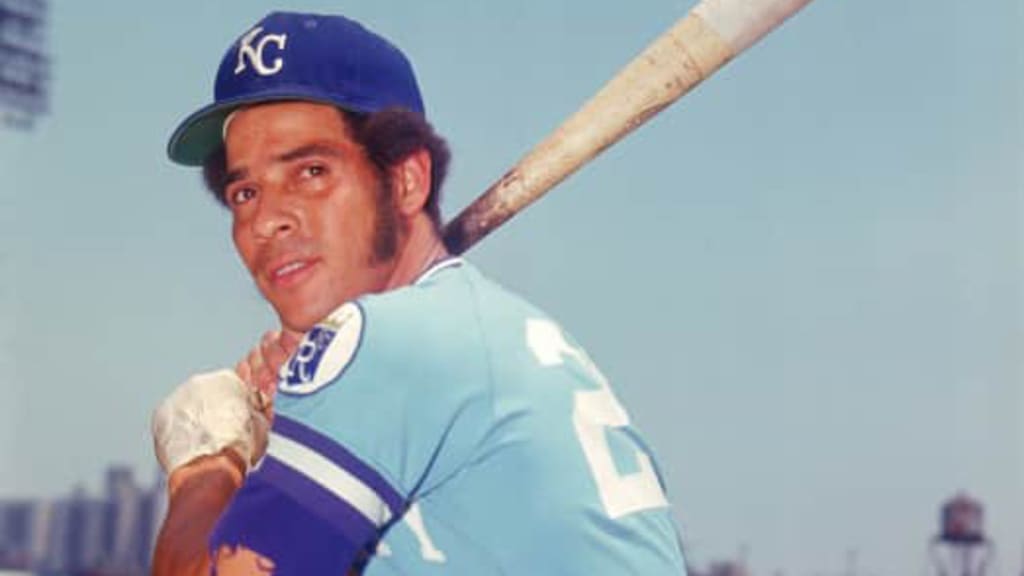
No one loves a good debate quite like baseball fans, and with that in mind, we asked each of our beat reporters to rank the top five players by position in the history of their franchise, based on their career while playing for that club. These rankings are for fun and debate purposes only … if you don’t agree with the order, participate in the Twitter poll to vote for your favorite at this position.
Here is Jeffrey Flanagan’s ranking of the top 5 center fielders in Royals history. Next week: Right fielders.
1. Amos Otis, 1970-83
Key facts: Five-time All-Star, three-time Gold Glove Award winner
How good was Otis?
Frank White, the Royals’ best second baseman of all time, said this of Otis a few years ago: "When people ask me about the guys I played with, they will say, ‘George Brett is the greatest hitter in Kansas City history.’ And I agree with that. But as far as a player, if you judge him in every facet of the game, this guy here [Amos Otis] is the best player who ever played for the Kansas City Royals.”
Otis finished his Royals career with 1,977 hits (2,020 overall).
“If I had played 21 years, I might have gotten to 3,000 hits,” Otis once said. “Plus, I was playing in a big ballpark in Kansas City, so that took away from hits and home run totals. In today’s ballparks, I might have hit 400 home runs and have had a shot at the Hall of Fame. Hey, I didn’t make the Hall of Fame, but I still think I had a decent career.”
In 14 seasons with the Royals, Otis recorded 365 doubles, 193 home runs and 340 stolen bases. He twice led the American League in doubles, and once in stolen bases.
But Otis’ best season came in 1973, when he hit 26 home runs with 93 RBIs and posted an .851 OPS. He won a Gold Glove Award that year, was an All-Star and finished third in AL MVP Award voting.
2. Willie Wilson, 1976-90
Key facts: Two-time All-Star, one-time Gold Glove Award and AL batting title winner (1982)
Simply put, Wilson had breathtaking speed. He finished in the top 10 in stolen bases across MLB for six seasons, and his 83 swipes in 1979 topped the Majors.
And Wilson used that speed everywhere on the diamond. His 230 hits and 133 runs scored in 1980 led the Majors. He also led either the Majors or the AL in triples in five seasons during his career.
“It was just such a weapon to have him at the top of the lineup,” Brett said. “It was always taking that extra base, always putting pressure on the defense. Teams were scared on how to defend our speed.”
Wilson finished his career with 2,207 hits and 668 stolen bases.
3. Carlos Beltrán, 1998-2004
Key fact: 1999 AL Rookie of the Year Award winner
Virtually all of Beltrán’s hardware came after he was traded from the Royals in 2004, except for his AL Rookie of the Year Award after hitting 22 home runs with 108 RBIs in 1999.
Beltrán’s post-Royals career included nine All-Star Games, three Gold Glove Awards and two Silver Slugger Awards. He finished his career with 2,725 hits and 435 home runs.
Royals fans got to see all that talent develop at Kauffman Stadium. Beltran hit 123 home runs with the Royals and drove in 516 runs; four times he collected at least 100 RBIs in a season in Kansas City.
“He was just so smooth as a player,” Mike Sweeney said. “It just looked effortless.”
4. Lorenzo Cain, 2011-17
Key fact: 2014 AL Championship Series MVP
Cain obviously was a key component to the Royals’ back-to-back World Series appearances in 2014-15, with a title in ’15.
That Cain never won a Gold Glove Award in Kansas City is borderline shameful -- he was a baron taking away hits nightly in spacious Kauffman Stadium.
Cain’s improvement offensively became evident in 2014, when he hit .301 with 29 doubles. His ALCS numbers that earned him MVP honors were remarkable: a .533/.588/.667 slash line.
Cain got even better in 2015, posting a career-high .838 OPS with career highs in doubles (34) and home runs (16) as well.
5. Johnny Damon, 1995-2000
Key facts: Led AL in steals (46) and runs (136) in 2000
Damon was a force in that offensive-minded Royals era of the late 1990s. He had speed and some pop (18 home runs in '98). And he knew how to get on base -- .379 on-base percentage in '99, .382 in 2000.
Damon’s best year clearly came in 2000, when he posted a career-high OPS of .877. A below-average arm limited him defensively, though.
Honorable mentions
• David DeJesus, 2003-10: Certainly could have made a case to put DeJesus in Damon’s spot. DeJesus had average speed and power, but he had a .360 on-base percentage in Kansas City and was a solid player.
• Brian McRae, 1990-94: B-Mac was a heady player who, like his father Hal, knew how to play the game right. McRae was a better defender than an offensive force in K.C.
• Tom Goodwin, 1994-97: Goody sure could fly. He stole 66 bases in '96.
